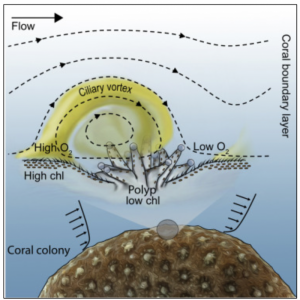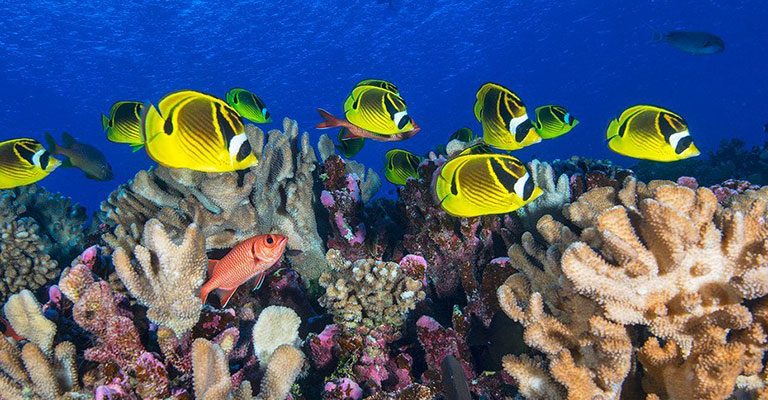By Laurie Henry
Coral reefs are not only one of the most biodiverse ecosystems on our planet, they also weigh heavily economically. With direct income from fishing in their waters, reefs provide a resource and services worth billions of dollars every year. They are also the drug pool of the 21st century. But global warming, because it impacts the temperature of the oceans, causes them to wither and jeopardizes all biodiversity. Yet, some corals exhibit remarkable coping strategies in the face of these changes in their environment. What are these strategies, what are the adaptive capacities of these corals and can we draw inspiration from them to restore damaged reefs?
Climate change is having profound impacts on marine ecosystems due to increased frequency and severity of marine heat waves. It induces high mortality in the most fragile organisms, especially those that cannot move to seek a more lenient area, such as corals. When the temperature of the water becomes too hot, the latter expel the microalgae living inside their tissues, which causes them to turn white and die.
Heat stress (increased heat of marine waters) is expected to worsen over the coming decades, but it is unclear to what extent and how organisms will adapt. This is why understanding and apprehending which individuals, within a coral population, are more tolerant to heat is fundamental to predicting the impacts of ocean warming.
A recent study by Newcastle University and the Palau International Coral Reef Center, published in the journal Proceedings Of The Royal Society B: Biological Sciences, sheds new light on coral reef protection and restoration programs through the prism of the climate change.
We do not all perceive heat in the same way
The type of response that an organism presents to the heat can vary throughout the heatwave episode. An individual who seems more heat tolerant at first may appear sensitive later on. It’s quite similar in humans, moreover, since within the same family, some tolerate heat waves well while for others, it’s a real ordeal every time! This tolerance is influenced by many genes and environmental factors.
This is why the authors of this study sought a way to objectively estimate the heat tolerance of corals. They attempted to associate bleaching and mortality with prolonged heat wave conditions. To study this variability, the researchers exposed corals taken from a single reef to an experimental marine heat wave for 30 days.
More tolerant corals, a valuable aid in maintaining coral reefs
According to the scientists’ analysis, an additional 4.8°C above the current temperature is “necessary” to induce bleaching and mortality in the 10% most tolerant corals, with the other corals supporting much lower temperatures.
Based on these results, the authors estimate that in a “reasonable” greenhouse gas emissions scenario, it will take up to 17 years before near-total coral mortality. This time frame is limited to only 10 years under a high emissions scenario.
Surprisingly, this variation does not appear to be related to the type of algae hosted by the corals, suggesting that the coral itself is more tolerant of heat. This individual variability and its heritability suggest the possibility of natural evolution, or assisted if necessary, to limit the impacts of climate change in the short term. But why are some corals more heat tolerant than others, when nothing seems to differentiate them?
An adaptation based on ventilation
This is precisely the question that a recent study by the Alfred Wegener Institute and the Helmholtz Center For Polar And Marine Research set out to answer. They highlighted a ventilation system built into the corals.
The researchers revealed that the algae sheltered by corals are not evenly distributed within a colony, with some areas having more of them than others. These algae release oxygen which, although vital for most organisms, can be dangerous when it is in excess, especially in waters that have become warmer or more acidic due to global warming. Oxygen dissolves very badly in warm waters, unlike cold waters, and somehow stagnates at the level of corals. It is then that the algae “re-process” more and more of this surrounding oxygen, and no longer the carbon dioxide. Which is not only less efficient in terms of energy production, but also damages the cells of the corals. The latter separate and whiten.
So to resist the heat, the corals, thanks to the tiny hairs (or eyelashes) on their surface, create local currents in order to specifically ventilate the areas rich in algae and “get rid” of this excess oxygen. It is these corals, equipped with this integrated ventilation system, which seem to be adapting to the warming of the oceans.

Illustration of the ventilation system of corals increasing their tolerance to heat. From Cesar O. Pacherres et al, 2022
These two studies, alongside IPCC climate projections, can guide coral reef conservation and restoration measures, by identifying the most heat-tolerant corals and planting them in damaged reefs.


